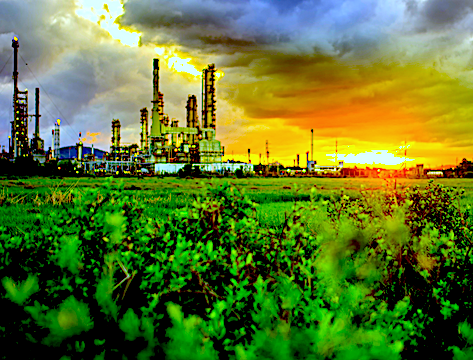Manufacturing plants, process plants, and other industrial facilities are natural economic drivers for the communities in which they operate. These businesses offer good jobs that, in turn, fuel economic activity. People move into the area, and homes, apartments, schools, hotels, restaurants, and shopping centers, among other things, are built to accommodate and cater to them. Unfortunately, the relationships between industrial facilities and nearby communities aren’t always harmonious. A land-buffer zone offers an easy solution that can restore harmony and enable continued economic growth in the community. More on that later.
Let’s look at the interface between a facility and the people in a community. If the plant emits light, dust, odors, smoke, and the like, people living nearby complain, which can affect the site’s ability to operate and/or require expenditures to address the offending elements. Facilities also may emit hazardous or toxic effluent that can contaminate an area’s water supply. And, in the worst instances, explosions or toxic releases of gas or vapor at industrial facilities can put people in surrounding communities at significant risk.
Then there’s the fact that industrial facilities and their neighbors frequently must deal with adverse weather events (particularly in low-lying areas near the sea). A prime example is U.S. regions around the Gulf of Mexico. Petrochemical and other process plants dot the coastal landscapes of Texas, Louisiana, Mississippi, and Alabama. If adverse weather such as a hurricane, for example, hits these areas, wind speeds typically receive all the news coverage. But it’s the water and the storm surge that cause much of the damage.
When land is developed in those regions, natural streams, flood plains, and wetland areas are often filled in, which exacerbates flooding caused by rainfall and storm surges. Not only is such flooding dangerous for people, it can cause major (and enormously costly) damage to industrial facilities located in the hard-hit areas. Wetlands, in particular, are very effective at absorbing storm surge. But when intermittent streams and wetlands are filled in and developed, the ecosystem services they offer are lost forever.
An excellent option for the forward-thinking industrial-facility operator is to create a compatible-use land buffer around the site. This type of land-buffer zone offers several important benefits. Among other things, it keeps people at a reasonable distance from the facility, which can reduce complaints about noise, dust, light, odors, and other annoyances, and also protects neighboring communities in the event of dangerous incidents, such as a toxic releases or explosions.
A land-buffer zone can also offer several ecosystem services. A riparian type of buffer, i.e., a heavily vegetated and managed portion of land near a facility’s fence line, serves to filter liquid releases that might escape from the plant and prevents their entry into the watershed. Moreover, for facilities located near a coastal area, maintaining, restoring, or creating wetlands can substantially reduce the risk of damage to the facility in the event of a major storm surge.
The bottom line here? Creating a land-buffer zone around your plant can help ensure sustainable operations.TRR
Editor’s Note: For more information on this topic, see “The Geoscience of Reliability Engineering: Preparing the Process Plant for Natural Disasters,” by Jennifer Cole and Drew Troyer, published in the Oct. 2019 issue of Hydrocarbon Processing.
ABOUT THE AUTHOR
Drew Troyer has 30 years of experience in the RAM arena. Currently a Principal with T.A. Cook Consultants, he was a Co-founder and former CEO of Noria Corporation. A trusted advisor to a global blue chip client base, this industry veteran has authored or co-authored more than 250 books, chapters, course books, articles, and technical papers and is popular keynote and technical speaker at conferences around the world. Drew is a Certified Reliability Engineer (CRE), Certified Maintenance & Reliability Professional (CMRP), holds B.S. and M.B.A. degrees, and is Master’s degree candidate in Environmental Sustainability at Harvard University. Contact him directly at 512-800-6031 or dtroyer@theramreview.com.
Tags: sustainability, sustainable manufacturing, geoscience, natural disasters, disaster preparedness, process safety, climate change, reliability, availability, maintenance, RAM



